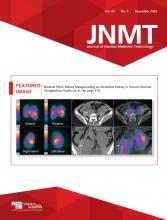Abstract
Fanconi anemia (FA) is a genetic disease associated with a risk of congenital malformations, bone marrow failure, and a predisposition to cancer. Congenital abnormalities of the kidney and urinary tract are not infrequent in FA, with renal ectopia being among them. The incidence of bilateral pelvic kidney is restricted to only a few reported cases; however, its association with FA has never, to our knowledge, been reported in the literature. We present a case of FA in a girl whose 99mTc-dimercaptosuccinic acid planar scan showed apparently fused kidneys, which were confirmed to be bilateral pelvic kidney on hybrid cross-sectional imaging.
Fanconi anemia (FA) is an inherited disease associated with various congenital and developmental abnormalities. The incidence of congenital abnormalities of the kidneys and urinary tract is reported to be around 30% (1). It is important to include anatomic and functional imaging studies in the diagnostic workup of FA. Furthermore, knowledge of renal disease is important in the management of FA at diagnosis and when planning during the clinical course (2). To the best of our knowledge, the incidence of bilateral pelvic kidney associated with FA has never been reported in the literature. We present an interesting case of FA with bilateral pelvic kidney masquerading as fused kidneys on a 99mTc-dimercaptosuccinic acid (99mTc-DMSA) planar scan; the fused kidneys were confirmed to be bilateral pelvic kidney on SPECT/CT imaging.
CASE HISTORY
An 11-y-old girl presented to the pediatric emergency ward with complaints of easy fatiguability and decreased oral intake for the last 10 d. Her blood investigations revealed pancytopenia. She received 2 transfusions of packed red blood cells and underwent bone marrow aspiration to evaluate the cause of the pancytopenia. She had experienced similar complaints in the past, for which she was given blood transfusions at other hospitals. Clinical manifestations and detailed laboratory tests revealed that the patient had FA. An abdominal radiograph followed by abdominal ultrasound raised the possibility of bilateral fused, low-lying kidneys. She was referred to our department for functional imaging in the form of a 99mTc-DMSA scan to diagnose the fused kidneys and to evaluate their individual functioning. A planar scan of the abdomen was obtained 3 h after intravenous injection of 92.5 MBq (2.5 mCi) of 99mTc-DMSA. The images, which were acquired in anterior, posterior, right lateral, and left lateral views (Figs. 1A, 1B, 1E, and 1F), revealed bilateral low-lying kidneys in a paramedian location, with the kidneys appearing to be fused at the midline. The differential function for the left and right kidneys was 43% and 57%, respectively. However, SPECT/CT acquired for confirmation showed the kidneys to be separate from each other on transaxial and coronal images from the low-dose CT portion of the study (Figs. 1C and 1G) and on the corresponding fused SPECT/CT images (Figs. 1D and 1H).
99mTc-DMSA planar scan in anterior, posterior, right, and left lateral views (A, B, E, and F) revealed low-lying kidneys bilaterally in paramedian location, with the 2 kidneys apparently fused at midline. On transaxial and coronal SPECT/CT, kidneys were clearly separate from each other both on low-dose CT component (C and G, arrows) and on fused images (D and H, arrows).
DISCUSSION
FA is an inherited disease resulting from defects in the FA/BRCA pathway for DNA interstrand crosslink repair. Around a third to a half of these patients may have associated congenital abnormalities of the kidneys and urinary tract pointing to a deranged normal ascent of the embryonic kidneys and resulting in iliac or pelvic renal ectopia (2,3). The incidence of pelvic kidney is around 1 in 2,200–3,000 people; however, bilateral pelvic kidney is a very rare developmental renal anomaly and is diagnosed mostly when patients develop symptoms due to obstruction, infection, and renal calculi (4). Anatomic and functional evaluation of renal malformations in patients with FA is important for the diagnostic work-up and for long-term management to improve the outcome by appropriate treatment. Every patient with renal abnormalities should be evaluated first with ultrasound and then by other imaging modalities. 99mTc-DMSA SPECT/CT has the advantage of providing both an anatomic and a functional evaluation for ectopic renal tissue anywhere from the thorax to the pelvis with a high degree of sensitivity in a single session (5).
CONCLUSION
Our case highlights the role of SPECT/CT to detect morphologic anomalies and cortical defects and to avoid misinterpretation of findings on planar scintigraphy.
DISCLOSURE
No potential conflict of interest relevant to this article was reported.
Footnotes
Published online Feb. 23, 2022.
REFERENCES
- Received for publication November 18, 2021.
- Revision received February 3, 2022.








